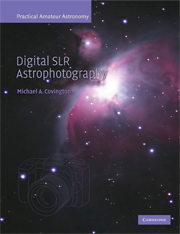Book contents
- Frontmatter
- Contents
- Preface
- Part I Basics
- Part II Cameras, lenses, and telescopes
- 5 Coupling cameras to telescopes
- 6 More about focal reducers
- 7 Lenses for piggybacking
- 8 Focusing
- 9 Tracking the stars
- 10 Power and camera control in the field
- 11 Sensors and sensor performance
- Part III Digital image processing
- Part IV Appendices
- Index
11 - Sensors and sensor performance
Published online by Cambridge University Press: 21 August 2009
- Frontmatter
- Contents
- Preface
- Part I Basics
- Part II Cameras, lenses, and telescopes
- 5 Coupling cameras to telescopes
- 6 More about focal reducers
- 7 Lenses for piggybacking
- 8 Focusing
- 9 Tracking the stars
- 10 Power and camera control in the field
- 11 Sensors and sensor performance
- Part III Digital image processing
- Part IV Appendices
- Index
Summary
CCD and CMOS sensors
Electronic image sensors work because light can displace electrons in silicon. Every incoming photon causes a valence electron to jump into the conduction band. In that state, the electron is free to move around, and the image sensor traps it in a capacitive cell. The number of electrons in the cell, and hence the voltage on it, is an accurate indication of how many photons arrived during the exposure. Modern sensors achieve a quantum efficiency near 100%, which means they capture an electron for nearly every photon.
The difference between CCD and CMOS sensors has to do with how the electrons are read out. CCD stands for charge-coupled device, a circuit in which the electrons are shifted from cell to cell one by one until they arrive at the output (Figures 11.1, 11.2); then the voltage is amplified, digitized, and sent to the computer. The digital readout is not the electron count, of course, but is exactly proportional to it.
CMOS sensors do not shift the electrons from cell to cell. Instead, each cell has its own small amplifier, along with row-by-column connections so that each cell can be read out individually. There is of course a main amplifier along with other control circuitry at the output.
Which is better? Originally, CCDs had the advantage; CMOS image sensors were designed to be made more cheaply, with lower-grade silicon.
- Type
- Chapter
- Information
- Digital SLR Astrophotography , pp. 127 - 142Publisher: Cambridge University PressPrint publication year: 2007



